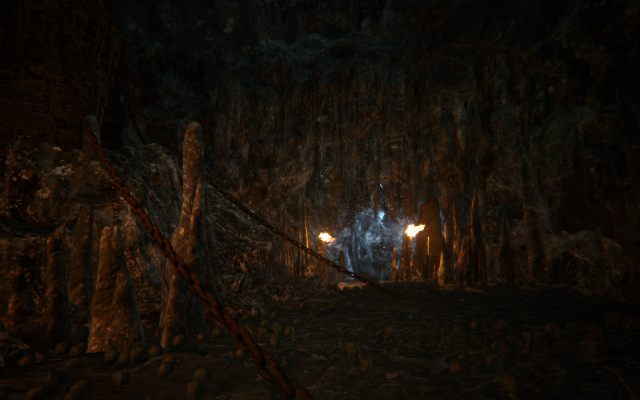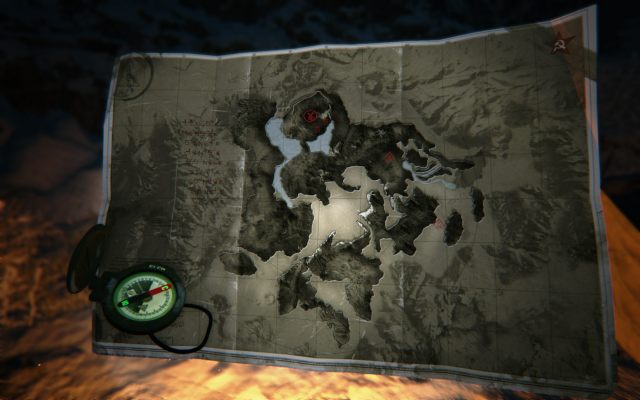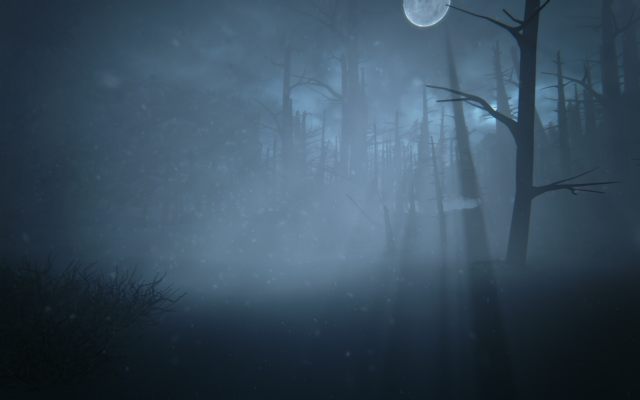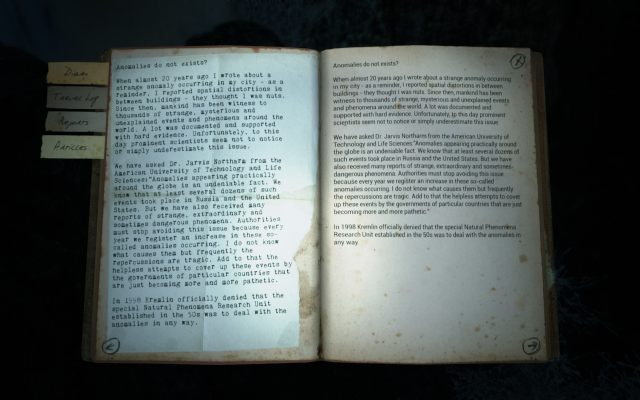Kholat – we’ve played the Polish exploration horror game
Bielsko-Biala, a small city in Poland, is the home to the developers of a horror inspired by Dear Esther and a mysterious tragedy from the past. What can we expect from Kholat? Now that we’ve had the chance to play the game, we can try to answer that.
“Press any button” – these words were the first thing I saw on the screen. A moment later I found myself on a vast glade covered in snow, right at the foot of a huge mountain. The moon was looming in the night sky, and a strong, piercing wind was ringing in my ears. I made a few steps forward; the snow creaked ominously under my feet. Suddenly, a flaming figure appeared before me. In my headphones I could hear the narrator’s voice, echoing my own bewilderment. The fiery figure soon vanished, but this short presence was enough to peak my curiosity. What is going on here? Why am I seeing such things? And most importantly – what is Kholat, a horror game announced a few months back, which still remains a rather enigmatic project?
To find an answer to this question, we went to Bielsko-Biala, Poland, where I had the chance to experience the episode mentioned above, and more. Here I also met the team of IMGN.pro, a local game publisher and, since recently, also a developer (they were the ones to publish, among other things, Euro Truck Simulator 2 and Spintires in Poland). With Polish dumplings, cabbage soup, salmon and vodka – this is how the producers greeted me and several other journalists from Poland and other countries in a local tavern. Sadly, I drove there so I had to turn down the liquor. This way, however, I kept my mind clear before setting foot in the mountains, and I can tell you one thing: some weird stuff happens there.
Fiction with a grain of truth
Let’s start with what you probably already know – Kholat is inspired by a mysterious incident from many years ago. Back in 1959, a group of Russian mountaineers led by Igor Dyatlov were found dead in the northern region of the Ural Mountains. To this day it is unknown what really caused their demise, although many theories have arisen. Actually, you don’t have to stuff your heads with this knowledge right now, since the authors provide a recap of the essential information in a brief introduction to the game. What is more important, they are actually more interested in legends and myths that have emerged around the so-called Dyatlov Pass, rather than searching for the truth. In this sense, the game will present a full version of the events and give answers to some questions. What we are really going to find here are stories within a story – other, minor threads hidden between the lines. Perhaps they will prove to be even more interesting than any attempts to guess what really happened in the mountains.
Let’s go back for a moment to the ill-fated event from 1959. I was wondering what was the authors’ approach to dealing with its historical background, not only in relation to their attempt to reveal the story behind the incident. It turns out that they chose probably the most appropriate way to do that, given that the game itself has been designed for an audience wider than a few fanatic hunters for the truth behind the death of Dyatlov’s group (if such people even exist). “This is not a documentary game”, explained Lukasz Kubiak, the writer and a co-owner of IMGN.pro. The producer added that some events and locations were based on their authentic counterparts, but other than that, the game is pure fiction. It quickly proved to be true, as I was delving farther and farther into the local folklore full of mysticism, occultism, and deadly yellow fog… Yes, my friends, I was terrified to no end by yellow fog.
Traipsing around & running for your life
Everything started out nicely – with a lot of walking. IMGN.pro admits that Kholat was inspired by Dear Esther, which is apparent from the very first step you take in the game. Here, we scramble through the sectioned game world, searching for places that might peak our interest, listening to narrators, and most importantly reading notes. We can find a few dozen of those in the game, including 16 main ones that build the main story line. Notes are more or less concealed and they often trigger certain events, such as the appearance of the aforementioned yellow mist.
We can hear four different narrators in the game. At least one voice should sound familiar – the authors employed Sean Bean, the actor famous for many cult movies and TV shows (The Lord of the Rings and Game of Thrones, just to name a few). Bean’s characters have a peculiar tendency to die on screen. I wonder if his hero is going to survive in the rough conditions high in the mountains.
I stumbled across it when I managed to find an ancient throne room with a horned skeleton on the royal seat. After I read the message, the skeleton turned to dust, and a yellow haze began to seep into the room. The game doesn’t provide many hints, but this time they weren’t necessary. As someone who has lived in the industrial region of Silesia for more than 30 years, I am perfectly aware that weird-looking gases should be avoided like the plague. Therefore, I started to flee down the hill, and while doing so, trying to avoid other dangers, such as falling rocks. It would only take a second-long break for the fog to catch up with the player – then a strange spectral figure with claws and decidedly unfriendly intentions would emerge from the darkness. Luckily, the escape itself was not very difficult, so I quickly reached a safe camp with a bonfire.
Map, compass and isolation
At first, Kholat seemed rather uncomplicated – all I had to do was progress straight ahead and carefully watch the events unfold. I was concerned that this was how it was going to be for the rest of the game, but soon I was forced to reevaluate my opinion. Once I reached the aforementioned campfire, the game informed me that I may use a fast travel system. It was then that Kholat spread its wings. The game plays out on an open map with multiple paths we can take in any order. The demo we were shown included only one third of the entire world, but it was enough for me to get lost. This happened mostly because the game doesn’t let the player know their exact position on the map. Instead, we have to read the coordinates on the map and use a compass to find our way. What is more, every now and then, we come across some mysterious coordinates written on a wall. Despite what you may think, they don’t indicate our current position.
Exploration is far from trivial, and that’s what makes it interesting. Unless you’ve been unable to learn basic cartography all your life – in that case Kholat will become your worst nightmare. For me, a seasoned hiker, it was an enjoyable experience, even despite several cases when I ended up going in circles. This abovementioned statement proves even truer when the game changes the atmosphere of a given location in a blink of an eye. One minute we are wandering through a forest during a blizzard, and the other we descent into a damp cave and listen to water dripping rhythmically. This variety will be even greater in the full version of the game, as we will be able to visit a small town at the foot of the mountain. As it turns out, Kholat is not only about the mountains.
Fear vs. fascination
There are games in which the possibility of imminent death is one of the aspects building up the feeling of dread. In others, scaring the player in this manner is not necessary. The developers of Kholat chose the former approach, but let me elaborate on that. Yes, you can die in the game in a variety of ways: fall down a slope, get smashed by a rock or become pray of dark creatures roaming around. Perhaps this was caused by the construction of the demo, but I didn’t feel threatened much; it seems to me that the authors didn’t intend to evoke a recurring fear in the players. Indeed, there were some disturbing moments in which I had to be careful, but most of the time the atmosphere resembled that of a, say, tourist hike. Of course, this is not the exact phrase I’ve been looking for and I don’t want you to get the wrong impression, as I don’t mean it in a bad way. Even given the above “drawback”, the game manages to make up for it with amazing design and atmosphere, which I’m going to comment upon in a moment.
It’s just that Kholat is not Amnesia: The Dark Descent. It’s more along the lines of Amnesia: A Machine for Pigs, where encounters with enemies are not exactly in the vein of “quake in your boots, because you are going to die”. “Kholat is not a survival horror, and we are saying this whenever possible”, concluded Kubiak. “We call Kholat an exploration game with horror elements”. Indeed, scaring the player too much in such a large environment might kill the core value of the game that is the careful exploration of its story. With such priorities, monsters should be unleashed very carefully, and it seems the creators of Kholat are aware of that. On the other hand, Kholat has more “gameplay elements”, as Kubiak referred to them, than, say, Dear Esther. People who found this title boring, should enjoy the new game by IMGN.pro.
Amazing atmosphere and a few slips
There is one thing that somehow tainted my experience with Kholat. Actually, these are two interconnected elements: character control system and unclear level design of some locations. The character can walk and sprint for a couple of seconds, but cannot jump. Hopping like a lunatic isn’t something I need to be happy, as long as all levels are designed perfectly. In the version I tested they weren’t, and a couple of times I was unsure if I could reach a certain place.
One of the game producers later explained that this may have been caused partly by limitations imposed on the demo version, which offered only a fragment of the entire game world. Some blocks and unclear elements should be therefore removed in the full version. I also wish there was a chance to do what Hansel, the fairy-tale character did, that is mark the places already visited. As I said, I got lost in the forest a few times, thus coming back to square one. It could all be easily avoided if the trails were blazed, like it’s done in the real mountains!
Time to go hiking
Kholat will take us hiking in April this year. The authors have no time left for drastic changes in game design. Luckily, these are not necessary. However, Kholat still requires some finishing touches and bug hunting; in a production like this even the smallest issues can be more irritating than in a typical action game. If this is done right, we will get a really intriguing horror based on a beautifully created world and skillfully built atmosphere of isolation, multiplied by the experience of power of nature and occult mysticism.
Will a brilliant plot follow? We have to wait and see, but I believe that the team from IMGN.pro is not going to disappoint us. These are very generous people – once again thank you for the invitation! – with a great sense of humor. When I asked Kubiak about his sales expectations, he joked that he counted on “17 million copies”. You have to admire this kind of ambition, and I’ll leave it at that.






